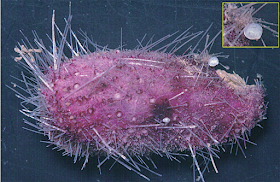The Echinoidea, sea urchins, are commonly divided between regular and irregular forms. In regular echinoids, representing the ancestral type for the class, the mouth and anus are positioned at opposite points on the test. The mouth sits squarely in the centre of the animal's underside (the oral surface) while the anus sits at the centre of the upper (aboral) surface. The five ambulacra, the lines of small plates in the test from which the tube feet emerge, are more or less evenly arranged around the superficially radially symmetrical test. Irregular echinoids, in contrast, have the anus more or less displaced from the midpoint of the test. In the earliest irregular echinoids, this displacement might be relatively slight: the periproct (the membrane through which the anus opens, usually covered in echinoids with an array of small plates) was still found at the centre of the aboral surface but was enlarged and/or stretched towards one end of the test (Saucède et al. 2007). In more derived forms, the periproct has moved more significantly, potentially being found on the side of the test or even on the oral surface near the mouth.
This displacement of the anus indicates a directionality to the test that isn't found in regular echinoids. A number of other changes have associated it in the evolution of echinoids, such as reduction of the size of the spines covering the test and an increased directionality in their axes of movement. The mouth may also become displaced towards the front of the test, and the test as a whole may become more bilateral in its overall shape. The jaws become modified or, in a couple of groups, lost entirely. All these alterations add up to indicate a distinct change in lifestyle between regular and irregular echinoids. Whereas regular echinoids roam the surface of sea bottom, using their powerful jaws to graze directly on algae or scavenge on animal carcasses, irregular echinoids are deposit feeders that tend to live at least partially buried in the sidement. They may swallow large amounts of sediment and digest organic matter mixed therein, or gather up organic particles with their tube feet and/or by means of mucous strands transported in ciliary grooves. Burrowing is achieved by movement of the spines or by using the tube feet to pass sand grains above the aboral surface. In the shallow-burrowing heart urchin Spatangus purpureus, an array of longer spines on the aboral surface are used to keep a funnel open between the buried urchin and the surface, allowing water to carry oxygen to it. Echinocardium cordatum, which burrows as deep as 18 cm beneath the substrate surface, maintains an opening to the surface by means of elongate tube feet (Durham 1966).
The change in lifestyle was certainly a successful one: nearly 60% of living echinoids are irregular. The earliest irregular echinoids appeared in the early Jurassic, with recent analyses agreeing that they represent a monophyletic group (Saucède et al. 2007; Kroh & Smith 2010). Nevertheless, a certain degree of parallelism in adaptations appears to have been occurred. Living irregular echinoids can be divided between two clades: one is relictual, containing only two genera in the order Holectypoida, whereas the remaining species belong to the larger clade Microstomata. The earliest known members of the holectypoid lineage retained strong jaws even after they evolved the ability to burrow in sediment. In contrast, the earliest known member of the Microstomata retained large spines, indicating a non-burrowing lifestyle, but already possessed the adaptations for a particulate diet (Saucède et al. 2007). With time, both lineages developed the feature that they lacked, adding them together for a winning combination.
REFERENCES
Durham, J. W. 1966. Echinoids—ecology and paleoecology. In: Moore, R. C. (ed.) Treatise on Invertebrate Paleontology pt U. Echinodermata 3 vol. 2 pp. U257–U265. The Geological Society of America, Inc., and The University of Kansas Press.
Kroh, A., & A. B. Smith. 2010. The phylogeny and classification of post-Palaeozoic echinoids. Journal of Systematic Palaeontology 8 (2): 147–212.
Saucède, T., R. Mooi & B. David. 2007. Phylogeny and origin of Jurassic irregular echinoids (Echinodermata: Echinoidea). Geological Magazine 144 (2): 333–359.



No comments:
Post a Comment
Markup Key:
- <b>bold</b> = bold
- <i>italic</i> = italic
- <a href="http://www.fieldofscience.com/">FoS</a> = FoS